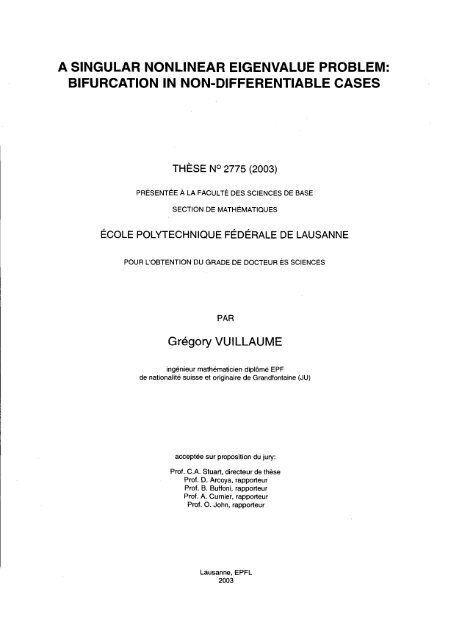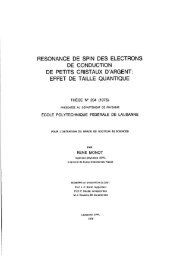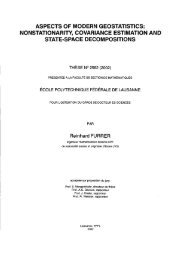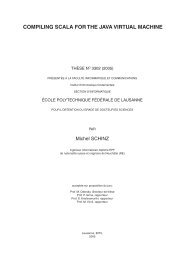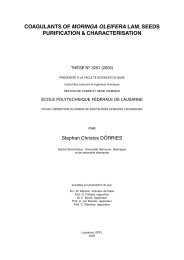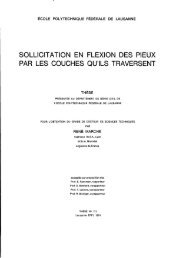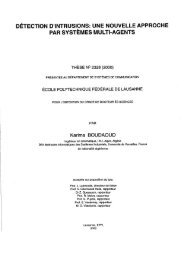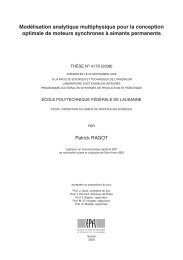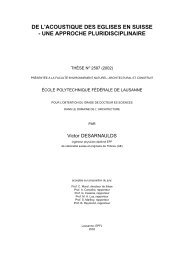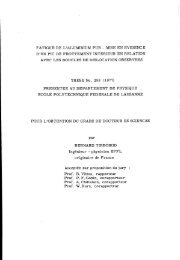a singular nonlinear eigenvalue problem: bifurcation in non ... - EPFL
a singular nonlinear eigenvalue problem: bifurcation in non ... - EPFL
a singular nonlinear eigenvalue problem: bifurcation in non ... - EPFL
You also want an ePaper? Increase the reach of your titles
YUMPU automatically turns print PDFs into web optimized ePapers that Google loves.
A SINGULAR NONLINEAR EIGENVALUE PROBLEM:<br />
BIFURCATION IN NON-DIFFERENTIABLE CASES<br />
PRÉSENTÉE À LA FACULTÉ DES SCIENCES DE BASE<br />
SECTION DE MATHÉMATIQUES<br />
ÉCOLE POLYTECHNIQUE FÉDÉRALE DE LAUSANNE<br />
POUR L'OBTENTION DU GRADE DE DOCTEUR ÈS SCIENCES<br />
PAR<br />
Grégory VUILLAUME<br />
<strong>in</strong>génieur mathématicien diplômé EPF<br />
de nationalité suisse et orig<strong>in</strong>aire de Grandfonta<strong>in</strong>e (JU)<br />
acceptée sur proposition du jury:<br />
Prof. C.A. Stuart, directeur de thèse<br />
Prof. D. Arcoya, rapporteur<br />
Prof. B. Buffoni, rapporteur<br />
Prof. A. Curnier, rapporteur<br />
Prof. O. John, rapporteur<br />
Lausanne, <strong>EPFL</strong><br />
2003
Version abrégée<br />
Dans ce travail, on étudie le flambage d'une colonne effilée. Ce phénomène physique<br />
mène au problème <strong>non</strong>-l<strong>in</strong>éaire aux valeurs propres suivant (appelé problème P):<br />
{A(s)u'(s))'+ps<strong>in</strong>u(s) = O pour tout s E (0'1)'<br />
où A(s) E C([0,1]) est une fonction cont<strong>in</strong>ue sur [0,1] telle que A(s) > O pour tout s > O<br />
et lim,,o A(s)/sp = L pour des constantes p 2 O et L E (0,m). On étudie l'ensemble<br />
des solutions de ce problème et, plus particulièrement, on recherche<br />
-<br />
les po<strong>in</strong>ts p E IR+<br />
tels qu'une <strong>bifurcation</strong> se produit en (p,O).<br />
Stuart a montré (voir [18]) qu'il existe un nombre A(A) 2 O tel que, pour O 5 p <<br />
A(A), le problème P admet uniquement la solution triviale u O et que celle-ci m<strong>in</strong>imise<br />
l'énergie dans l'espace de Hilbert (que l'on note HA) de toutes les configurations admissibles.<br />
Pour p > A(A), il existe une solution <strong>non</strong>-triviale du problème P qui m<strong>in</strong>imise<br />
l'énergie. De plus, A(A) > O pour p E [0,2], tandis que A(A) = O pour p > 2.<br />
Pour O < p < 3, le problème P peut s'écrire sous la forme F(p,u) = O, où F :<br />
IR+ x HA -+ HA est un opérateur de la forme F(p,u) = u - pGA(u) et G,q : HA + HA<br />
est un opérateur complètement cont<strong>in</strong>u.<br />
Si O < p < 2, l'opérateur F est différentiable au sens<br />
-<br />
de Fréchet et, en utilisant<br />
des outils standards tels que le théorème de Crandall-Rab<strong>in</strong>owitz sur la <strong>bifurcation</strong> des<br />
valeurs propres simples et le théorème de Rab<strong>in</strong>owitz concernant la <strong>bifurcation</strong> globale,<br />
Stuart a prouvé qu'une <strong>bifurcation</strong> globale de la solution u O se produisait uniquement<br />
en l'ensemble discret des valeurs propres {pz1 : i E IV)' où pl = A(A), p,i < pi+l pour<br />
tout i E W et limi,, pi = m. De plus, ces valeurs propres sont fortement liées au<br />
spectre de la l<strong>in</strong>éarisation (au sens de Fréchet) de GA.<br />
Pour p = 2, F n'est plus<br />
-<br />
différentiable au sens de Fréchet, mais seulement différentiable<br />
au sens de Gâteaux. A<strong>in</strong>si, les outils standards comme ceux mentionnés ci-dessus ne<br />
s'appliquent plus. Toutefois, Stuart a montré l'existence d'un nombre &(A) E [A(A),m)<br />
tel qu'une <strong>bifurcation</strong> de u O se produit en chaque valeur p E [A,(A),oc~).<br />
Une grande partie de ce travail est consacrée au cas p = 2, où l'on suppose que<br />
A(A) < A,(A). Dans ce cas, il existe des valeurs propres {p;' : i E I IV) liées<br />
au spectre de la l<strong>in</strong>éarisation (mais ma<strong>in</strong>tenant au sens de Gâteaux) de GA telles<br />
-<br />
que<br />
A(A) = pl, pi < pi+l et A(A) 5 pi < A,(A) pour tout i E I. On démontre qu'une<br />
<strong>bifurcation</strong> (locale) de la solution triviale se produit en pi pour tout i E I. De plus, sous<br />
une hypothèse additionnelle sur A(s), on montre également qu'une bifurcaiion de u O
ne peut pas se produire en p E [O,A,(A)) si p # pi pour tout i E I (ceci n'est pas un<br />
résultat standard car F n'est pas différentiable<br />
-<br />
au sens de Fréchet) et qu'une <strong>bifurcation</strong><br />
globale (et pas seulement locale) de la solution triviale se produit en pi pour tout i E 1.<br />
Dans une autre partie de ce travail, on traîte le cas 2 < p < 3. Dans ce cas, A(A) = O<br />
et on prouve qu'une <strong>bifurcation</strong> de u O se produit en chaque p > 0.
Abstract<br />
This work is concerned with the study of the buckl<strong>in</strong>g of a tapered rod. .This physical<br />
phenome<strong>non</strong> leads to the follow<strong>in</strong>g <strong><strong>non</strong>l<strong>in</strong>ear</strong> <strong>eigenvalue</strong> <strong>problem</strong> called <strong>problem</strong> P:<br />
{A(s)ul(s))' + p s<strong>in</strong> u(s) = O for al1 s E (O, 1) ,<br />
~(1) = lim A(s)ul(s) = O<br />
1<br />
s-io<br />
1<br />
and A(s)u'(s)~~s < ml<br />
where ~(s) E C([O, 11) is such that A(s) > O for al1 s > O and lim,,,, A(s)/sP = L for<br />
some constants p 2 O and L E (O, CO). We study the set of al1 solutions of this <strong>problem</strong><br />
and, <strong>in</strong> particular, f<strong>in</strong>d the po<strong>in</strong>ts p E IR+ such that <strong>bifurcation</strong> occurs at (p, 0).<br />
Stuart proved <strong>in</strong> [18] that there is a number A(A) 2 O such that, for O 5 p 5 A(A),<br />
the only solution of <strong>problem</strong> P is the trivial solution u = O and it m<strong>in</strong>imizes the energy<br />
<strong>in</strong> the Hilbert space of al1 admissible configurations denoted by HA. For p :> A(A), there<br />
exists a <strong>non</strong>trivial solution of <strong>problem</strong> P m<strong>in</strong>imiz<strong>in</strong>g the energy. Moreover, A(A) > O<br />
for p E [O, 21 whereas A(A) = O for p > 2.<br />
For O 5 p < 3, <strong>problem</strong> P can be written <strong>in</strong> the form F(p, u) = O, where F :<br />
I$. x HA -+ HA is such that F(p, U) = u - pGA(u) and GA : HA -+ HA is a completely<br />
cont<strong>in</strong>uous operator.<br />
If O 5 p < 2, the operator F is Fréchet differentiable and, us<strong>in</strong>g standard tools<br />
like the theorem of Crandall-Rab<strong>in</strong>owitz concern<strong>in</strong>g <strong>bifurcation</strong> from simple <strong>eigenvalue</strong>s<br />
and the theorem of Rab<strong>in</strong>owitz concern<strong>in</strong>g global <strong>bifurcation</strong>, Stuart was able to prove<br />
that global <strong>bifurcation</strong> from the trivial solution u r O occurs only at a d.iscrete set of<br />
<strong>eigenvalue</strong>s {p~'<br />
: i E IT), where pl = A(A), pi < pi+l for al1 i E IV, and. limi+oo pi =<br />
CO. Moreover, these <strong>eigenvalue</strong>s are strongly related to the spectrum of the l<strong>in</strong>earization<br />
(<strong>in</strong> the sense of Fréchet) of GA.<br />
For p = 2, F is not Fréchet differentiable anymore, but only Gâteaux differentiable.<br />
Then, standard results like the ones mentioned above do not apply. However, Stuart<br />
was able to show that there is a number &(A) E [A(A), CO) such that <strong>bifurcation</strong> from<br />
u = O occurs at every value p E [&(A), CO).<br />
A big part of Our work is devoted to the case p = 2, where it is assumed that<br />
A(A) < A,(A). In this case, there exist <strong>eigenvalue</strong>s {,UT' : i E I C N*) related to<br />
the spectrum of the l<strong>in</strong>earization (but now <strong>in</strong> the sense of Gâteaux) of GA such that<br />
A(A) = pl, pi < pi+l and A(A) 5 pi < &(A) for al1 i E I. We prove that (local)<br />
<strong>bifurcation</strong> from the trivial solution occurs at pi for al1 i E I. Moreoier, under an<br />
additional assumption on A(s), we also prove that <strong>bifurcation</strong> from u rz O does not<br />
occur at p E [O, &(A)) if p # pi for al1 i E I (this is not a standard result s<strong>in</strong>ce F is not
Fréchet differentiable) and that global (and not only local) <strong>bifurcation</strong> frorn the trivial<br />
solution occurs at pi for al1 i E I.<br />
In another part of this work, the case 2 < p < 3 is discussed. In this case, A(A) = O<br />
and we prove that <strong>bifurcation</strong> from u r O occurs at every p 2 0.
TABLE OF CONTENTS vii<br />
Table of Contents<br />
Version abrégée i<br />
Abstract iii<br />
Acknowledgment s v<br />
List of figures ix<br />
1 Introduction 1<br />
1.1 Orig<strong>in</strong> of the <strong>problem</strong> ............................. 1<br />
1.2 Def<strong>in</strong>ition of the <strong>problem</strong> ........................... 5<br />
2 Prelim<strong>in</strong>aries 11<br />
2.1 The energy space HA ............................. 11<br />
2.2 The l<strong>in</strong>earized <strong>problem</strong> ............................ 13<br />
2.3 Previous work of Stuart ........................... 16<br />
2.4 Genus of a set ................................. 21<br />
2.5 Degree for k-set contractions ......................... 22<br />
3 Taper<strong>in</strong>g of order 2 < p < 3 25<br />
3.1 Some properties of HA ............................ 25<br />
3.2 A useful functional .............................. 27<br />
3.3 Bifurcation for 2 < p < 3 ........................... 32<br />
4 Profiles of order 2 37<br />
4.1 Notation and useful results .......................... 37<br />
4.2 Bifurcation for p = 2 ............................. 41<br />
5 Cl-Profiles of order 2 47<br />
5.1 Concern<strong>in</strong>g P,. ................................ 47<br />
5.2 Global <strong>bifurcation</strong> ............................... 63<br />
5.3 Shape of the branches ............................ 67
...<br />
Vlll<br />
6 Conclusion<br />
A Example<br />
B Existence of <strong>eigenvalue</strong>s<br />
C Number of zeros of eigenvectors<br />
D Proof of Theorem 5.10<br />
E On the functional<br />
Bibliography<br />
TABLE OF CONTENTS


